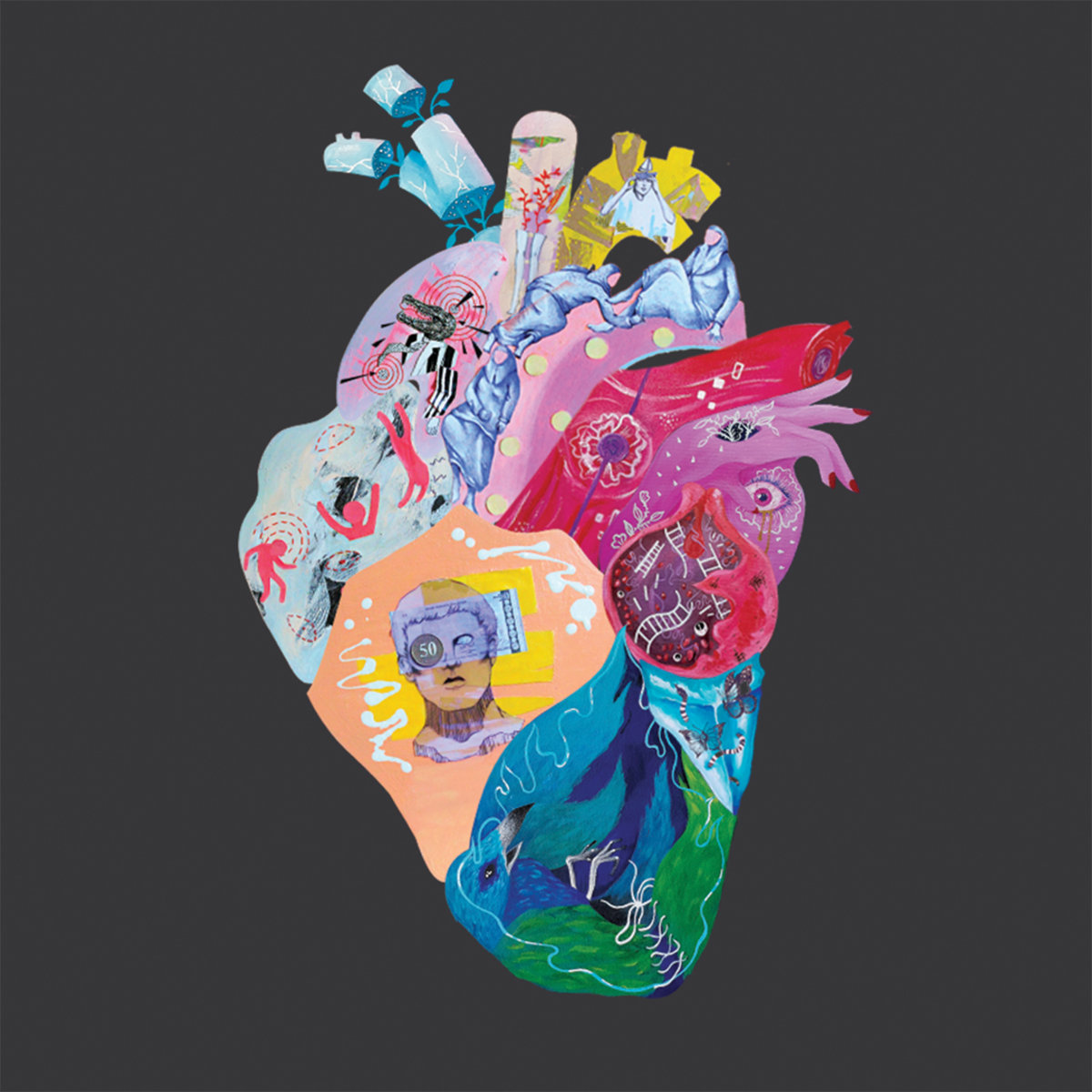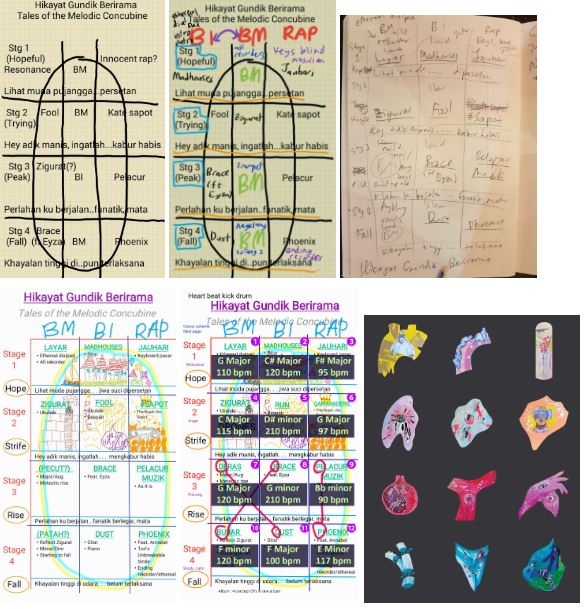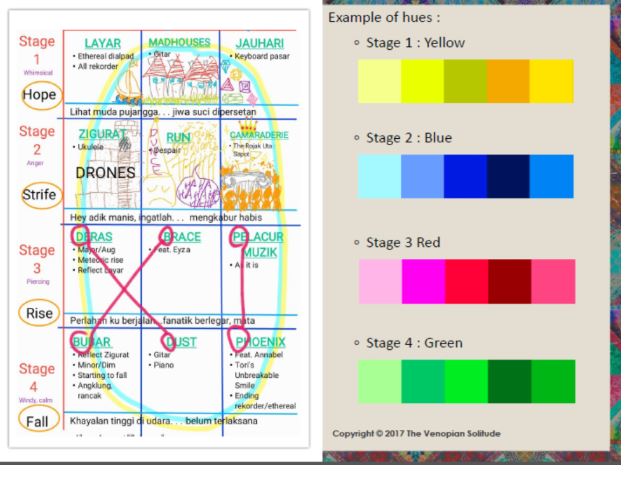Written by Zim Ahmadi
On 22 June 2019, the experimental pop band The Venopian Solitude (TVS) released their second full-length album, “Hikayat Gundik Berirama”. “Experimental pop” doesn’t really begin to describe this seminal band for contemporary Malaysian music. Led by frontwoman Takahara Suiko, the band incorporates sounds from all over the place, including traditional music, electronic music, pop, rock and hip hop – all creating this genreless sonic environment for Takahara’s often story-oriented lyrics.
There could have been many ways for you to discover The Venopian Solitude, whether it’s through Takahara Suiko’s viral songs, her hit track “Tenangkan Bontot Anda”, her solo project VIONA or the KFC commercial they did earlier this year!
In their second album “Hikayat Gundik Berirama”, the band solidifies their skills at storytelling. In fact, the entire album is one big story centred around the “gundik” (or in English, “concubine”). Divided into four chapters, the album takes all of what The Venopian Solitude has been known for in their previous work and turns it up to theatrical proportions.

The Venopian Solitude at Sonar Festival 2018
Five years since The Venopian Solitude’s debut, Hikayat Perawan Majnun, the band has also reached plenty of other milestones, including touring in Europe at the Sonar Festival 2018 in Barcelona alongside the likes of Thom Yorke, Masego, Bonobo, Diplo and more. At the time that this article was written, The Venopian Solitude is touring in places like Taiwan for GMA 2019 and also parts of Europe.
In our efforts at exploring the process behind making the album, we got to talk to Takahara Suiko about the ins-and-outs of what makes Hikayat Gundik Berirama special.
This Q&A has been paraphrased and altered for more accessible reading.
ZA – Zim Ahmadi
TS – Takahara Suiko
ZA: It’s been five years since your debut Hikayat Perawan Majnun. The journey of conceptualizing a whole new album must have been arduous, especially because of other projects and commitments. How does it feel like to finally let it all out? Was this a harder baby to deliver than the first? Or did all of you have a clearer sense of what to expect now?
TS: It feels cathartic to finally push this baby out of the womb. It was much harder for the second album because first and foremost, there was no project manager to whip us into completing the album according to schedule, and there were a lot of last-minute shows and tours where we had to plan the trip for ourselves. That’s why it took 3 years longer than it’s supposed to be. But at the same time, because of the delay, the music we consumed changed the landscape of the album, hence changing our writing into something more cohesive than it was supposed to be three years ago.
ZA: For the sake of this written interview, could you give an overview as to the visuals aka the artistic direction of the album? It is designed by Dhanillani and Uliu, and shows pieces of a heart put together representing each song. Was this heart already fully realized in your head when you developed a story for HGB?

Image 1: Hikayat Gundik Berirama album art
TS: Because it is a written interview, here’s the overview of what the drafts look like :

Image 2: Draft 1, 2, 3, 4, 5(final), song artwork layout
Originally it was supposed to be an egg-shaped thing that was divided into twelve pieces. But as we work on the album, there was a unifying sound that stood out in every song; a double kick sound that was similar to a heartbeat, so I decided to change the shape to a heart. The original plan was to approach 12 different painters to paint each artwork based on the lyrics/ stories and what they feel upon listening to the songs(similar to what Kimbra did for The Golden Echo), but we can’t afford it haha. But I’ve been meaning to work with both Uliu(Alia) and Dhanilliani anyway upon stumbling their artwork online(aka excessive stalking), so I decided to collaborate with them for this project. I only determined the colours for each stage, and for them to make sure the drawings are within the heart-piece outlines. The rest was up to them.

Image 3: Colours and Columns
ZA: Hope. Strife. Rise. Fall. Do the chapters of HGB also reflect your emotional journey throughout the creation of the album? Are they a statement of bigger humanity? Both?
TS: It’s more like the journey of the originally-innocent lass who slowly turns into a boastful ‘pelacur’, and then God sends His wrath and takes all her fame and fortune, then she learns her lesson and the vicious cycle repeats (hence the recorder sound at the start of Layar is also audible at the end of Phoenix). It’s the cycle of life but represented in the context of a Pelacur Muzik.
ZA: Did your solo projects as VIONA inform the creative process at all? Is VIONA the Gundik?
TS: VIONA could be the gundik (in the long run should she lost herself in fame and fortune), but it wasn’t what I had in mind.
I think it fine-tunes the process further. It helps me decide faster, because the entire idea of VIONA is to finish the song in 2-3 days, and the MV in the next 2-3 days. That means we, TVS (aka The Venopian Solitude), have to work within our budget and at a very limited time(we were chasing for completion before we leave for Taiwan and Europe) and it sort of worked out in every aspect of the project. Efficiency without having to jeopardise the concept.
ZA: Though there are only three features, they’re all very intriguing and diverse! How did the collab with Lawa Nie Geng, Asmidar, and Eyza Bahra happen?
TS:
Eyza Bahra : I wrote a song back in 2014-2015, after getting heavily inspired by Sanjay Leela Bhansali’s movie and soundtrack, Goliyoon Ki Rasleela Ram-Leela(specifically the song Lahu Munh Lag Gaya). The beats were based on the song’s stick drums but in 5/4 signature.
It was supposed to be a chill project, zero-promo kind of project, but after it was done, it sort of sat in the hard drive for a while. I think only after getting all the draft concept ready did I think that it suits the concept.
Lawa Nie Geng : Originally this part of the album was supposed to be an epic collaboration with Arabyrd and Rubba.Bend, where Arabyrd writes a Sarawakian verse and Rubba.Bend raps in Tamil, and I write in Japanese(dibs on the idea now that it’s out lol), but Rubba.Bend apparently was out of the industry(or so I hear), and I feel like it wouldn’t work well without her. Tried emailing and contacting her but to no avail.
So I told Arabyrd that this might not happen, and at the same time trying to think of something else to replace this song which has to feature hip-hop artists(based on the column that says Rap just for the sake of organising the concept). I immediately thought of Lawa Nie Geng, after the collaboration I had with Lawalah Familia in their mixtape. It suits them perfectly because the journey that they’ve gone through whilst being in the mainstream industry articulately reflects the theme of that section of the album.
Asmidar : This was another song wherein the collaboration was supposed to happen but didn’t. At the same time, the first version of the song was completely different from what it is now, except for the end part of the song where I thought, ‘hey, Kak Asmidar would be great in this’. But if I were to pursue this song, her part wouldn’t be prominent and it would be towards the end of the song, which would be a waste.
After the other intended collaborators couldn’t do it, (mainly from my end, but we’re on good terms!), I felt like this song needed a revamp. But instead of rearranging the song, I ended up writing a completely new song, slightly inspired by Jacob Collier’s With the Love in My Heart’s manic arrangement and Asmidar’s new endeavour, Keronchong Bilek Ayer. It is the last song to be written in the album and was written on December 2018.
ZA: I was so happy to hear “Dust”! You did an interview with a really small YouTube channel called “Beyond the Lines” 2 years ago and you explained that the song was about a person who has lost everything. On stage, it was “selepas kiamat”. Are these synonymous to you? Did a lot of songs start out personal and intimate and became something very big later?
Both are technically the same concept. It’s a follow up of Bubar, where the apocalypse is happening; i.e, God taking all the fame and fortune away from the ‘Pelacur Muzik’, and Dust is basically what happens after the apocalypse; which is basically padang jarak padang terkukur.
I think the only song that was intimate to me in the album is Pelacur Muzik, because it was written after someone on the interwebs called me a Pelacur Muzik for requesting payment for performances, instead of ‘doing it for the arts’. Everything else was written based on the concept(except Brace and Zigurat, that fitted the storyline from the get go simply by going with a different interpretation), and Zigurat was actually about Najib, Rosmah, and their 1MDB crew.
The categorisation of the diagram(columns of BI, BM and Rap, and rows of ‘stages’ in the Pelacur Muzik’s journey) helped to organise the album, and better my writing at the same time. Because I feel that without it the second album would be a bit of a mess, especially in terms of storyline. And it’s a great challenge to pursue because I began to arrive at the point where I can write about anything and everything that it doesn’t challenge me much anymore.
ZA: Good luck for your time in Taiwan and Europe! I’m still holding on to that dream that HGB will someday become a play since it’s already divided into babaks.
That’s our goal too! Hope to collaborate with a theatre production to make this a reality(which I already have in mind I think haha, but that’s for later!).
Find out more about the band at thevenopiansolitude.com. Check out their latest album on Bandcamp.


